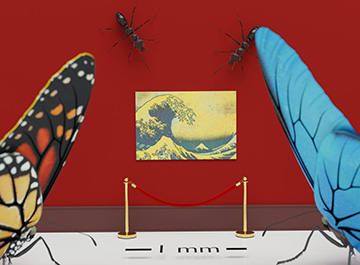![]()
Using structural colors in stressed polymer films, researchers at Kyoto University were able to print, without ink, this 3-mm-square image of Vermeer’s famous "Girl with a Pearl Earring." [Image: Kyoto University iCeMS]
A research team at Kyoto University, Japan, has developed a method that uses standing-wave optics to design, control and organize stress fields within plastic films—and thereby create high-resolution images from the resulting structural colors (Nature, doi: 10.1038/s41586-019-1299-8). The researchers believe that the novel printing method, which reportedly can create images at resolutions of 14,000 dots per inch (dpi) without a drop of ink, could find a home in application spheres ranging from banknote security to wearable biomedical devices.
Structural color from “crazing”
The roots of the team’s process lie in a familiar phenomenon seen in plastics, known as “crazing.” When a piece of plastic or a plastic film is stretched or bent, networks of fine cracks, microcavities and hairlike structures called microfibrils tend to form around stress “hot spots” within the polymer structure. Scattering of light from these tiny stress-induced imperfections is responsible for the milky white color that results, for example, from the repeated bending of a stiff piece of plastic.
The Kyoto team, led by Easan Sivaniah, reasoned that through control of the growth and cross-linking of those tiny structures in a plastic film, the effects could go well beyond that opaque white, allowing the design of specific colors in targeted areas through the phenomenon of structural color. The same effect that imparts color to the wings of a butterfly, structural color involves no pigments. Instead, the color stems from the interference of light scattered off of nanostructures such as the scales in the butterfly’s wing—or tiny microfibrils in a stressed piece of plastic.
Layer by layer
To get from these ideas to a practical inkless printing scheme, Sivaniah’s team began with a deep dive into the chemistry and physics of stress-induced polymer crazing and microfibrils. The researchers knew that when a plastic film is immersed in a weak solvent such as acetic acid, the acid will permeate the plastic enough to accelerate local cavity and microfibril formation, while leaving the basic polymer film structure intact. Experiments with polystyrene films spin-cast onto a silicon wafer substrate revealed that these effects yielded stepwise changes in the films’ colors as layer after layer of microfibrils formed and then collapsed.
The Kyoto researchers analyzed the process to fully understand where these effects were coming from, taking scanning electron microscope snapshots at different time steps to document the microstructural changes as the solvent penetrated the polymer structure. They also used optical transfer matrix analysis and spectroscopy to get at the details of how these micro- and nanoscale changes result in structural colors. The key, they found, is that the solvent creates a periodic structure of alternating dense and porous layers within the plastic—the optical result of which is standing waves that interfere to create the varying colors.
LED-enabled control
Next, the team looked at how to actually control these microstructural elements to go from interference-induced colors to the formation of an image. The control know that they settled on was a bank of LEDs, which could be used to shape the evolving stress field in the film. “The layer periodicity is a standing-wave phenomenon,” the researchers write in the study, “so we can alter it by crosslinking with different wavelengths of light.”
After chemically tweaking a polystyrene film to make it photosensitive across a wavelength range from below 280 nm up to 405 nm, the researchers exposed the acetic-acid-treated films to light from a number of LEDs within that range. The team established that the periodic cross-linking triggered by the illumination in the light-sensitive films could induce stresses within the plastic.
Those stresses, by organizing the microfibril geometry, in turn shifted the Bragg peak in the film spectrum to create different structural colors—with the shift amount increasing as the wavelength of the incident light increased. While the maximum illumination wavelength was only 405 nm, the technique could be used to produce colors across the entire 400-to-700-nm visible band.

One output of the Kyoto researchers’ technique—which leverages the same phenomenon that creates the color on a butterfly’s wing—was a 1-mm-square image of Katsushika Hokusai’s “Great Wave.” [Image: Kyoto University iCeMS]
An inkless “Great Wave”
By creating shadow masks on overhead-transparency sheets with computer-graphics software—with a different mask for each wavelength—the team was able to use the light-triggered, stress-induced changes (which the researchers call “organized stress microfibrillation”) to make structural-color images in the polymer films. With this technique, the researchers built exquisite, square-millimeter-scale images of celebrated artworks such as Johannes Vermeer’s “Girl with a Pearl Earring,” Leonardo da Vinci’s “Mona Lisa,” and Katsushika Hokusai’s “Great Wave.” The team showed that, by using micro-LEDs as the illumination source, features as fine as 1.8 μm could be resolved, for a resolution on the order of 14,000 dpi.
The team believes that the principle of using “optically generated stress fields to develop organized, tunable microstructures within polymers” could find a wide range of applications, such as anti-forgery images on banknotes and even wearable devices for biomedicine.
The technique “allows us to print porous networks for gases and liquids, making it both breathable and wearable,” Sivaniah said, in a press release accompanying the work. “So, for example in the area of health and well-being, it is possible to incorporate it into a kind of flexible ‘fluid circuit board’ that could sit on your skin or your contact lenses to transmit essential biomedical information to the cloud or directly to your health care professional.”
